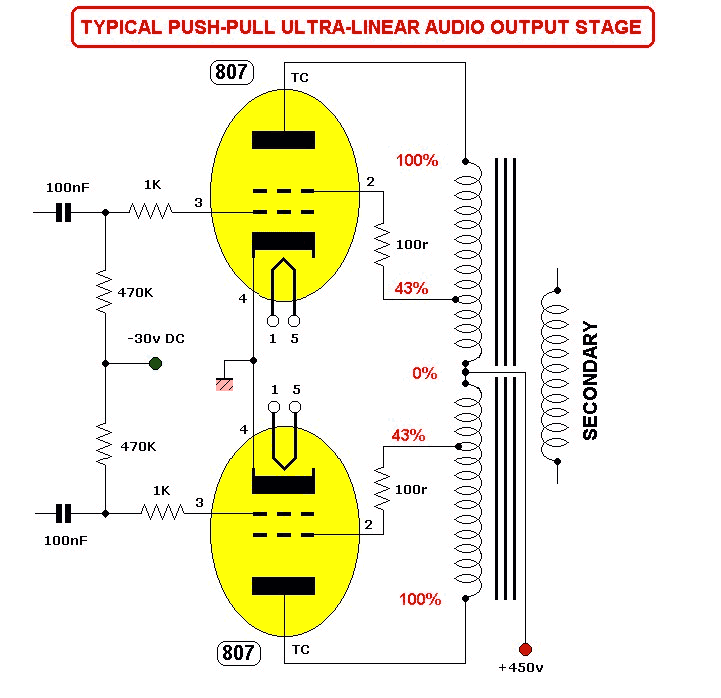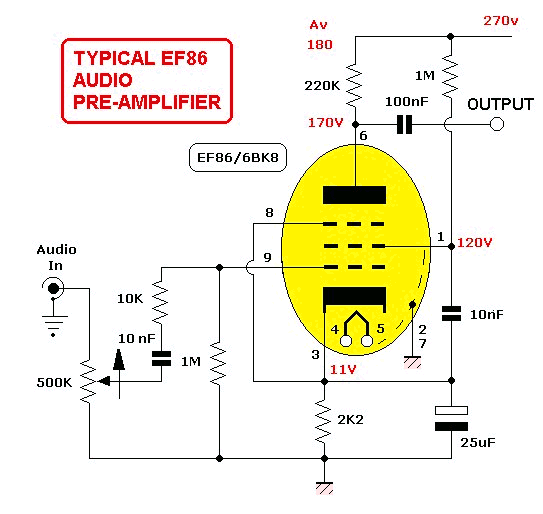ULTRA - LINEAR
AUDIO
AMPLIFIERS
by Frank v Hughes VK6FH
Observations: from published literature relating to the so called "ULTRA
LINEAR" type of audio amplifier: as used in valve based HiFi, Public address,
Modulator amplifiers etc.

In a push-pull amplifier (compared to a parallel pair of valves): 2nd
Harmonic distortion produced by either valve is cancelled by equal and opposite
distortion from the other.
Two triodes in Push-pull therefore give
greater undistorted output than if connected in parallel. 3rd harmonic
distortion does not cancel in this way; pentodes whose output is limited by 3rd
harmonics therefore do not share in this particular advantage.
They can
be made to do so by connecting their screen grids to suitable tapping’s on the
primary of the output transformer, in what is rather absurdly called the
"Ultra-Linear" system.
FOUNDATIONS OF WIRELESS 7TH EDITION: SCROGGIE
(1958) pp319
Ultra-Linear operation provides a compromise between the high efficiency
of tetrodes and the low distortion and uncritical load impedance of
triodes.
There is an undoubted advantage in modulator service because the
matching of the modulator to the RF stage is not so critical and the screen (DC)
supply is obtained "automatically" from the transformer.
Screen grid
tappings: 43% gives minimum distortion 20% gives maximum power.
RSGB
handbook 4th Edition (1968) pp9.19
Patent 496,883 dated 5 June 1937 is one which is considered to be among
the most important, which later became known as the "Ultra - Linear"
amplifier.
With so many of Blumlein’s circuits the design is deceptively
simple.
It shows a pentode output stage of a single ended audio
frequency amplifier with a tap on the primary winding of the output transformer.
This tap provided feedback to the second grid to improve the linearity of
the amplifier.
Blumlein realized that if the tap was placed at the Anode end
of the primary winding, the valve would then be connected as a triode, and if
the tap was at the supply end, it would be a pure pentode.
It was well
known that when a pentode was connected as a triode it would be far less
efficient and therefore provide a lower power output. If however the tap was
placed at a distance 15-20% down from the supply end of the supply end of the
transformer, the valve would combine positive features of both the triode and
the pentode.
The Ultra-Linear circuit in its push-pull form became
widely used in high-fidelity valve amplifiers during the second world war,
though it was a good many years before general practice caught up with
Blumlein’s thinking.
While Blumlein did not consider the problems
associated with distortion resulting from feedback to the screen, he regarded it
mainly as a convenient alternative to the control-grid feedback for reducing the
undesirably high impedance of pentodes while retaining their efficiency.
He did suggest lowering the output impedance of the valve to
approximately equal the optimum load. This would have been done in order to
prevent damage to the valve or the output transformer if, the load became
disconnected.
THE LIFE AND WORKS OF ALAN DOWER BLUMLEIN:
ROBERT
CHARLES ALEXANDER (2000) pp213
ADDITIONALLY:

The EF86 pentode
has a heater structure as a helix and an electrostatic shield around the anode
(mesh) both designed to reduce hum in audio circuits.
The input stage; an
EF86 pentode, is responsible for the high sensitivity but poor noise
performance of these amplifiers.
VALVE AMPLIFIERS: MORGAN JONES.
NEWNES (1995) pp224
If you have any questions related to this project then please refer them to
the author Frank
V. Hughes.
Return to INDEX page


